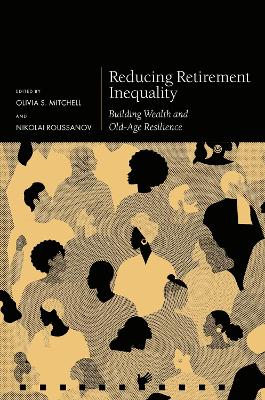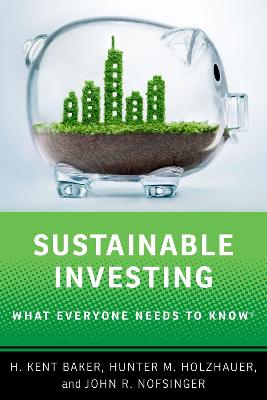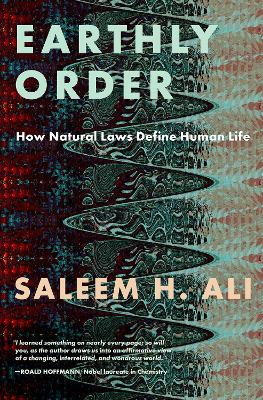Sustainable Investing
 -10%
portes grátis
-10%
portes grátis
Sustainable Investing
What Everyone Needs to Know
Nofsinger, John R.; Baker, H. Kent; Holzhauer, Hunter M.
Oxford University Press Inc
08/2022
270
Dura
Inglês
9780197643815
15 a 20 dias
478
Descrição não disponível.
Who Are the Authors?
Why Did We Write This Book?
Whom Do We Want to Thank?
What is the Book About?
Introduction
Chapter One: The Changing Investment Landscape: The Past, Present, and Future
1.1. What are the earliest origins of socially responsible investing (SRI) and corporate social responsibility (CSR)?
1.2. Who were the first drivers of SRI and CSR, and how did their efforts help establish the ways social responsibility activists affect corporate behavior?
1.3. What is screening, and why is it important?
1.4. What are the most critical milestones in the 20th century for SRI?
1.5. How did these earlier milestones in the 20th-century help establish how SRI activists could affect corporate behavior?
1.6. Who created the first modern SRI index?
1.7. How did environmental, social, and governance (ESG) criteria become the three primary social responsibility factors?
1.8. What are other vital issues in the 21st century for SRI and CSR besides ESG criteria?
1.9. What are the main ways that investors can participate in SRI and SDG efforts?
1.10. What are the similarities and differences between sustainable investing and green investing?
1.11. What are the similarities and differences between impact investing and community investing?
1.12. How have risk tolerances and investment preferences changed from a generational perspective?
1.13. What impact are Millennials and progressive politics making on sustainable investing?
1.14. What are the conservative politics of sustainable investing in terms of advocacy agenda?
1.15. What is the divide between progressive and conservative investors?
1.16. What trends are likely to drive the future of the sustainable investing industry?
Takeaways
Chapter Two: Corporate Social Responsibility: Delivering Both Profit and Purpose
2.1. What's corporate social responsibility?
2.2. What's business ethics?
2.3. Who are a firm's stakeholders?
2.4. How can a firm demonstrate its social responsibility?
2.5. How can firms be environmentally sustainable?
2.6. How do firms demonstrate social responsibility to society?
2.7. What firm governance characteristics are responsible?
2.8. How can firms exhibit social responsibility to employees?
2.9. How can a firm be socially responsible in some areas and not in others?
2.10. How does doing good differ from avoiding doing harm?
2.11. What is corporate philanthropy, and should firms be engaged in it?
2.12. How can firms become involved in community engagement?
2.13. How can investors determine whether a firm is socially responsible?
2.14. How are firms held accountable for CSR?
2.15. What is a non-governmental organization, and how does it interact with companies?
2.16. How can a firm have a social purpose and earn a profit?
2.17. How is CSR viewed around the world?
2.18. What companies are known as leaders in CSR?
2.19. What online resources are available for researching socially responsible firms?
Takeaways
Chapter Three: Social and Religious Values: Aligning Values and Portfolio Assets
3.1. What is values-based investing?
3.2. What community values can investors use to select investments?
3.3. How can investing include human and civil rights values?
3.4. What is environmental sustainability, and how can investors incorporate it into a portfolio?
3.5. What firm products are inconsistent with social responsibility?
3.6. What religious values affect investing?
3.7. How can investors consider Christian values?
3.8. How can investors consider Islamic values?
3.9. How can investors consider Jewish faith-based values?
3.10. How might socially progressive values affect investment choice?
3.11. What is patriotic investing?
3.12. How are stocks found using negative and positive social screens?
3.13. What stock indices benchmark socially responsible firms?
3.14. What are Morningstar's Sustainability Scores?
3.15. What are Morningstar's Carbon Risk Scores?
3.16. Where can investors find socially responsible mutual funds?
3.17. What exchange-traded funds have socially responsible portfolios?
3.18. Where can investors find sustainable bonds and other fixed-income funds?
3.19. What are online resources available for researching a values-based investment approach?
Takeaways
Chapter Four: Sustainable Investing: Making Money While Doing Good
4.1. How does traditional investing differ from sustainable investing?
4.2. What are the potential concerns about sustainable investing?
4.3. What is the screening approach to sustainable investing?
4.4. What is the ESG integration approach to sustainable investing?
4.5. What is the socially responsible investing approach?
4.6. What are the shareholder engagement and activism approaches to sustainable investing?
4.7. What is the sustainable thematic investing approach?
4.8. What is the impact investing approach to sustainable investing?
4.9. What types of investors engage in sustainable investing?
4.10. How large is the sustainable investing marketplace?
4.11. How can investors get started with sustainable investing?
4.12. What vehicles are available for aligning values with investments?
4.13. What are the sources available for evaluating the social responsibility of a good versus bad company?
4.14. What are the pros and cons of investing in ESG stocks?
4.15. What are some examples of the largest ESG stocks?
4.17. What are the similarities and differences between mutual funds and ETFs engaged in sustainable investing?
4.18. What are the different types of funds engaging in sustainable investing, and examples of each?
4.19. What options are available for socially responsible investors interested in fixed-income investments?
4.20. What are green bonds and their pros and cons?
4.21. What are social impact bonds and their benefits and challenges?
4.23. What are the advantages and disadvantages of ESG TDFs?
4.24. What are some tips in selecting an ESG TDF?
4.25. What are the trade-offs between investing in stocks or bonds of socially responsible companies, mutual funds, and ETFs?
4.26. What are robo-advisors and the trade-offs of using them for sustainable investing?
4.27. What are some examples of robo-advisors for sustainable investing?
4.28. What is community investing?
4.29. What are online sources of information for sustainable investing?
Takeaways
Chapter Five: Performance Implications of Sustainable Investing: Can You Have Your Cake and Eat It Too?
5.1. What are the supply and demand dynamics for performance data for sustainable investing?
5.2. What are the concerns about the performance data for sustainable investing?
5.3. What is the total number of sustainable investment funds?
5.4. Have sustainable investment funds outperformed traditional funds?
5.5. How has the performance of sustainable funds changed over time?
5.6. What are the performance implications of sustainable investment indices?
5.7. How fast is investor demand for sustainable investing growing?
5.8. What factors are likely to affect the demand for sustainable investing going forward?
5.9. Has the growth in investor demand driven the recent outperformance in sustainable investing??
5.10. Which of the three ESG criteria has historically performed better?
5.11. What are the performance implications of sustainable investing when analyzing the fixed-income market?
5.12. What performance critiques or implications relate to screening?
5.13. Do sin stocks outperform sustainable stocks?
5.14. Is sustainable investing ethical window dressing?
5.15. How has sustainable investing had a positive benefit on changing society or corporate behavior?
5.16. Can sustainable investors have their cake and eat it too?
Takeaways
Chapter Six: Building a Portfolio with a Purpose: How to Benefit You and Society
6.1. What are common misconceptions about sustainable investing?
6.2. Why should sustainable investors take a portfolio perspective?
6.3. What steps are in the portfolio management process?
6.4. What is an investment policy statement?
6.5. Why should sustainable investors have an investment policy statement?
6.6. What role does asset allocation play in the investment decision-making process?
6.7. What types or classes of assets are available to sustainable investors?
6.8. What are the main determinants of asset allocation?
6.9. What are the two most common strategies for asset allocation and their advantages and
6.11. What are other types of asset allocation strategies available?
6.12. What are some guidelines of asset allocation for
Why Did We Write This Book?
Whom Do We Want to Thank?
What is the Book About?
Introduction
Chapter One: The Changing Investment Landscape: The Past, Present, and Future
1.1. What are the earliest origins of socially responsible investing (SRI) and corporate social responsibility (CSR)?
1.2. Who were the first drivers of SRI and CSR, and how did their efforts help establish the ways social responsibility activists affect corporate behavior?
1.3. What is screening, and why is it important?
1.4. What are the most critical milestones in the 20th century for SRI?
1.5. How did these earlier milestones in the 20th-century help establish how SRI activists could affect corporate behavior?
1.6. Who created the first modern SRI index?
1.7. How did environmental, social, and governance (ESG) criteria become the three primary social responsibility factors?
1.8. What are other vital issues in the 21st century for SRI and CSR besides ESG criteria?
1.9. What are the main ways that investors can participate in SRI and SDG efforts?
1.10. What are the similarities and differences between sustainable investing and green investing?
1.11. What are the similarities and differences between impact investing and community investing?
1.12. How have risk tolerances and investment preferences changed from a generational perspective?
1.13. What impact are Millennials and progressive politics making on sustainable investing?
1.14. What are the conservative politics of sustainable investing in terms of advocacy agenda?
1.15. What is the divide between progressive and conservative investors?
1.16. What trends are likely to drive the future of the sustainable investing industry?
Takeaways
Chapter Two: Corporate Social Responsibility: Delivering Both Profit and Purpose
2.1. What's corporate social responsibility?
2.2. What's business ethics?
2.3. Who are a firm's stakeholders?
2.4. How can a firm demonstrate its social responsibility?
2.5. How can firms be environmentally sustainable?
2.6. How do firms demonstrate social responsibility to society?
2.7. What firm governance characteristics are responsible?
2.8. How can firms exhibit social responsibility to employees?
2.9. How can a firm be socially responsible in some areas and not in others?
2.10. How does doing good differ from avoiding doing harm?
2.11. What is corporate philanthropy, and should firms be engaged in it?
2.12. How can firms become involved in community engagement?
2.13. How can investors determine whether a firm is socially responsible?
2.14. How are firms held accountable for CSR?
2.15. What is a non-governmental organization, and how does it interact with companies?
2.16. How can a firm have a social purpose and earn a profit?
2.17. How is CSR viewed around the world?
2.18. What companies are known as leaders in CSR?
2.19. What online resources are available for researching socially responsible firms?
Takeaways
Chapter Three: Social and Religious Values: Aligning Values and Portfolio Assets
3.1. What is values-based investing?
3.2. What community values can investors use to select investments?
3.3. How can investing include human and civil rights values?
3.4. What is environmental sustainability, and how can investors incorporate it into a portfolio?
3.5. What firm products are inconsistent with social responsibility?
3.6. What religious values affect investing?
3.7. How can investors consider Christian values?
3.8. How can investors consider Islamic values?
3.9. How can investors consider Jewish faith-based values?
3.10. How might socially progressive values affect investment choice?
3.11. What is patriotic investing?
3.12. How are stocks found using negative and positive social screens?
3.13. What stock indices benchmark socially responsible firms?
3.14. What are Morningstar's Sustainability Scores?
3.15. What are Morningstar's Carbon Risk Scores?
3.16. Where can investors find socially responsible mutual funds?
3.17. What exchange-traded funds have socially responsible portfolios?
3.18. Where can investors find sustainable bonds and other fixed-income funds?
3.19. What are online resources available for researching a values-based investment approach?
Takeaways
Chapter Four: Sustainable Investing: Making Money While Doing Good
4.1. How does traditional investing differ from sustainable investing?
4.2. What are the potential concerns about sustainable investing?
4.3. What is the screening approach to sustainable investing?
4.4. What is the ESG integration approach to sustainable investing?
4.5. What is the socially responsible investing approach?
4.6. What are the shareholder engagement and activism approaches to sustainable investing?
4.7. What is the sustainable thematic investing approach?
4.8. What is the impact investing approach to sustainable investing?
4.9. What types of investors engage in sustainable investing?
4.10. How large is the sustainable investing marketplace?
4.11. How can investors get started with sustainable investing?
4.12. What vehicles are available for aligning values with investments?
4.13. What are the sources available for evaluating the social responsibility of a good versus bad company?
4.14. What are the pros and cons of investing in ESG stocks?
4.15. What are some examples of the largest ESG stocks?
4.17. What are the similarities and differences between mutual funds and ETFs engaged in sustainable investing?
4.18. What are the different types of funds engaging in sustainable investing, and examples of each?
4.19. What options are available for socially responsible investors interested in fixed-income investments?
4.20. What are green bonds and their pros and cons?
4.21. What are social impact bonds and their benefits and challenges?
4.23. What are the advantages and disadvantages of ESG TDFs?
4.24. What are some tips in selecting an ESG TDF?
4.25. What are the trade-offs between investing in stocks or bonds of socially responsible companies, mutual funds, and ETFs?
4.26. What are robo-advisors and the trade-offs of using them for sustainable investing?
4.27. What are some examples of robo-advisors for sustainable investing?
4.28. What is community investing?
4.29. What are online sources of information for sustainable investing?
Takeaways
Chapter Five: Performance Implications of Sustainable Investing: Can You Have Your Cake and Eat It Too?
5.1. What are the supply and demand dynamics for performance data for sustainable investing?
5.2. What are the concerns about the performance data for sustainable investing?
5.3. What is the total number of sustainable investment funds?
5.4. Have sustainable investment funds outperformed traditional funds?
5.5. How has the performance of sustainable funds changed over time?
5.6. What are the performance implications of sustainable investment indices?
5.7. How fast is investor demand for sustainable investing growing?
5.8. What factors are likely to affect the demand for sustainable investing going forward?
5.9. Has the growth in investor demand driven the recent outperformance in sustainable investing??
5.10. Which of the three ESG criteria has historically performed better?
5.11. What are the performance implications of sustainable investing when analyzing the fixed-income market?
5.12. What performance critiques or implications relate to screening?
5.13. Do sin stocks outperform sustainable stocks?
5.14. Is sustainable investing ethical window dressing?
5.15. How has sustainable investing had a positive benefit on changing society or corporate behavior?
5.16. Can sustainable investors have their cake and eat it too?
Takeaways
Chapter Six: Building a Portfolio with a Purpose: How to Benefit You and Society
6.1. What are common misconceptions about sustainable investing?
6.2. Why should sustainable investors take a portfolio perspective?
6.3. What steps are in the portfolio management process?
6.4. What is an investment policy statement?
6.5. Why should sustainable investors have an investment policy statement?
6.6. What role does asset allocation play in the investment decision-making process?
6.7. What types or classes of assets are available to sustainable investors?
6.8. What are the main determinants of asset allocation?
6.9. What are the two most common strategies for asset allocation and their advantages and
6.11. What are other types of asset allocation strategies available?
6.12. What are some guidelines of asset allocation for
Este título pertence ao(s) assunto(s) indicados(s). Para ver outros títulos clique no assunto desejado.
Who Are the Authors?
Why Did We Write This Book?
Whom Do We Want to Thank?
What is the Book About?
Introduction
Chapter One: The Changing Investment Landscape: The Past, Present, and Future
1.1. What are the earliest origins of socially responsible investing (SRI) and corporate social responsibility (CSR)?
1.2. Who were the first drivers of SRI and CSR, and how did their efforts help establish the ways social responsibility activists affect corporate behavior?
1.3. What is screening, and why is it important?
1.4. What are the most critical milestones in the 20th century for SRI?
1.5. How did these earlier milestones in the 20th-century help establish how SRI activists could affect corporate behavior?
1.6. Who created the first modern SRI index?
1.7. How did environmental, social, and governance (ESG) criteria become the three primary social responsibility factors?
1.8. What are other vital issues in the 21st century for SRI and CSR besides ESG criteria?
1.9. What are the main ways that investors can participate in SRI and SDG efforts?
1.10. What are the similarities and differences between sustainable investing and green investing?
1.11. What are the similarities and differences between impact investing and community investing?
1.12. How have risk tolerances and investment preferences changed from a generational perspective?
1.13. What impact are Millennials and progressive politics making on sustainable investing?
1.14. What are the conservative politics of sustainable investing in terms of advocacy agenda?
1.15. What is the divide between progressive and conservative investors?
1.16. What trends are likely to drive the future of the sustainable investing industry?
Takeaways
Chapter Two: Corporate Social Responsibility: Delivering Both Profit and Purpose
2.1. What's corporate social responsibility?
2.2. What's business ethics?
2.3. Who are a firm's stakeholders?
2.4. How can a firm demonstrate its social responsibility?
2.5. How can firms be environmentally sustainable?
2.6. How do firms demonstrate social responsibility to society?
2.7. What firm governance characteristics are responsible?
2.8. How can firms exhibit social responsibility to employees?
2.9. How can a firm be socially responsible in some areas and not in others?
2.10. How does doing good differ from avoiding doing harm?
2.11. What is corporate philanthropy, and should firms be engaged in it?
2.12. How can firms become involved in community engagement?
2.13. How can investors determine whether a firm is socially responsible?
2.14. How are firms held accountable for CSR?
2.15. What is a non-governmental organization, and how does it interact with companies?
2.16. How can a firm have a social purpose and earn a profit?
2.17. How is CSR viewed around the world?
2.18. What companies are known as leaders in CSR?
2.19. What online resources are available for researching socially responsible firms?
Takeaways
Chapter Three: Social and Religious Values: Aligning Values and Portfolio Assets
3.1. What is values-based investing?
3.2. What community values can investors use to select investments?
3.3. How can investing include human and civil rights values?
3.4. What is environmental sustainability, and how can investors incorporate it into a portfolio?
3.5. What firm products are inconsistent with social responsibility?
3.6. What religious values affect investing?
3.7. How can investors consider Christian values?
3.8. How can investors consider Islamic values?
3.9. How can investors consider Jewish faith-based values?
3.10. How might socially progressive values affect investment choice?
3.11. What is patriotic investing?
3.12. How are stocks found using negative and positive social screens?
3.13. What stock indices benchmark socially responsible firms?
3.14. What are Morningstar's Sustainability Scores?
3.15. What are Morningstar's Carbon Risk Scores?
3.16. Where can investors find socially responsible mutual funds?
3.17. What exchange-traded funds have socially responsible portfolios?
3.18. Where can investors find sustainable bonds and other fixed-income funds?
3.19. What are online resources available for researching a values-based investment approach?
Takeaways
Chapter Four: Sustainable Investing: Making Money While Doing Good
4.1. How does traditional investing differ from sustainable investing?
4.2. What are the potential concerns about sustainable investing?
4.3. What is the screening approach to sustainable investing?
4.4. What is the ESG integration approach to sustainable investing?
4.5. What is the socially responsible investing approach?
4.6. What are the shareholder engagement and activism approaches to sustainable investing?
4.7. What is the sustainable thematic investing approach?
4.8. What is the impact investing approach to sustainable investing?
4.9. What types of investors engage in sustainable investing?
4.10. How large is the sustainable investing marketplace?
4.11. How can investors get started with sustainable investing?
4.12. What vehicles are available for aligning values with investments?
4.13. What are the sources available for evaluating the social responsibility of a good versus bad company?
4.14. What are the pros and cons of investing in ESG stocks?
4.15. What are some examples of the largest ESG stocks?
4.17. What are the similarities and differences between mutual funds and ETFs engaged in sustainable investing?
4.18. What are the different types of funds engaging in sustainable investing, and examples of each?
4.19. What options are available for socially responsible investors interested in fixed-income investments?
4.20. What are green bonds and their pros and cons?
4.21. What are social impact bonds and their benefits and challenges?
4.23. What are the advantages and disadvantages of ESG TDFs?
4.24. What are some tips in selecting an ESG TDF?
4.25. What are the trade-offs between investing in stocks or bonds of socially responsible companies, mutual funds, and ETFs?
4.26. What are robo-advisors and the trade-offs of using them for sustainable investing?
4.27. What are some examples of robo-advisors for sustainable investing?
4.28. What is community investing?
4.29. What are online sources of information for sustainable investing?
Takeaways
Chapter Five: Performance Implications of Sustainable Investing: Can You Have Your Cake and Eat It Too?
5.1. What are the supply and demand dynamics for performance data for sustainable investing?
5.2. What are the concerns about the performance data for sustainable investing?
5.3. What is the total number of sustainable investment funds?
5.4. Have sustainable investment funds outperformed traditional funds?
5.5. How has the performance of sustainable funds changed over time?
5.6. What are the performance implications of sustainable investment indices?
5.7. How fast is investor demand for sustainable investing growing?
5.8. What factors are likely to affect the demand for sustainable investing going forward?
5.9. Has the growth in investor demand driven the recent outperformance in sustainable investing??
5.10. Which of the three ESG criteria has historically performed better?
5.11. What are the performance implications of sustainable investing when analyzing the fixed-income market?
5.12. What performance critiques or implications relate to screening?
5.13. Do sin stocks outperform sustainable stocks?
5.14. Is sustainable investing ethical window dressing?
5.15. How has sustainable investing had a positive benefit on changing society or corporate behavior?
5.16. Can sustainable investors have their cake and eat it too?
Takeaways
Chapter Six: Building a Portfolio with a Purpose: How to Benefit You and Society
6.1. What are common misconceptions about sustainable investing?
6.2. Why should sustainable investors take a portfolio perspective?
6.3. What steps are in the portfolio management process?
6.4. What is an investment policy statement?
6.5. Why should sustainable investors have an investment policy statement?
6.6. What role does asset allocation play in the investment decision-making process?
6.7. What types or classes of assets are available to sustainable investors?
6.8. What are the main determinants of asset allocation?
6.9. What are the two most common strategies for asset allocation and their advantages and
6.11. What are other types of asset allocation strategies available?
6.12. What are some guidelines of asset allocation for
Why Did We Write This Book?
Whom Do We Want to Thank?
What is the Book About?
Introduction
Chapter One: The Changing Investment Landscape: The Past, Present, and Future
1.1. What are the earliest origins of socially responsible investing (SRI) and corporate social responsibility (CSR)?
1.2. Who were the first drivers of SRI and CSR, and how did their efforts help establish the ways social responsibility activists affect corporate behavior?
1.3. What is screening, and why is it important?
1.4. What are the most critical milestones in the 20th century for SRI?
1.5. How did these earlier milestones in the 20th-century help establish how SRI activists could affect corporate behavior?
1.6. Who created the first modern SRI index?
1.7. How did environmental, social, and governance (ESG) criteria become the three primary social responsibility factors?
1.8. What are other vital issues in the 21st century for SRI and CSR besides ESG criteria?
1.9. What are the main ways that investors can participate in SRI and SDG efforts?
1.10. What are the similarities and differences between sustainable investing and green investing?
1.11. What are the similarities and differences between impact investing and community investing?
1.12. How have risk tolerances and investment preferences changed from a generational perspective?
1.13. What impact are Millennials and progressive politics making on sustainable investing?
1.14. What are the conservative politics of sustainable investing in terms of advocacy agenda?
1.15. What is the divide between progressive and conservative investors?
1.16. What trends are likely to drive the future of the sustainable investing industry?
Takeaways
Chapter Two: Corporate Social Responsibility: Delivering Both Profit and Purpose
2.1. What's corporate social responsibility?
2.2. What's business ethics?
2.3. Who are a firm's stakeholders?
2.4. How can a firm demonstrate its social responsibility?
2.5. How can firms be environmentally sustainable?
2.6. How do firms demonstrate social responsibility to society?
2.7. What firm governance characteristics are responsible?
2.8. How can firms exhibit social responsibility to employees?
2.9. How can a firm be socially responsible in some areas and not in others?
2.10. How does doing good differ from avoiding doing harm?
2.11. What is corporate philanthropy, and should firms be engaged in it?
2.12. How can firms become involved in community engagement?
2.13. How can investors determine whether a firm is socially responsible?
2.14. How are firms held accountable for CSR?
2.15. What is a non-governmental organization, and how does it interact with companies?
2.16. How can a firm have a social purpose and earn a profit?
2.17. How is CSR viewed around the world?
2.18. What companies are known as leaders in CSR?
2.19. What online resources are available for researching socially responsible firms?
Takeaways
Chapter Three: Social and Religious Values: Aligning Values and Portfolio Assets
3.1. What is values-based investing?
3.2. What community values can investors use to select investments?
3.3. How can investing include human and civil rights values?
3.4. What is environmental sustainability, and how can investors incorporate it into a portfolio?
3.5. What firm products are inconsistent with social responsibility?
3.6. What religious values affect investing?
3.7. How can investors consider Christian values?
3.8. How can investors consider Islamic values?
3.9. How can investors consider Jewish faith-based values?
3.10. How might socially progressive values affect investment choice?
3.11. What is patriotic investing?
3.12. How are stocks found using negative and positive social screens?
3.13. What stock indices benchmark socially responsible firms?
3.14. What are Morningstar's Sustainability Scores?
3.15. What are Morningstar's Carbon Risk Scores?
3.16. Where can investors find socially responsible mutual funds?
3.17. What exchange-traded funds have socially responsible portfolios?
3.18. Where can investors find sustainable bonds and other fixed-income funds?
3.19. What are online resources available for researching a values-based investment approach?
Takeaways
Chapter Four: Sustainable Investing: Making Money While Doing Good
4.1. How does traditional investing differ from sustainable investing?
4.2. What are the potential concerns about sustainable investing?
4.3. What is the screening approach to sustainable investing?
4.4. What is the ESG integration approach to sustainable investing?
4.5. What is the socially responsible investing approach?
4.6. What are the shareholder engagement and activism approaches to sustainable investing?
4.7. What is the sustainable thematic investing approach?
4.8. What is the impact investing approach to sustainable investing?
4.9. What types of investors engage in sustainable investing?
4.10. How large is the sustainable investing marketplace?
4.11. How can investors get started with sustainable investing?
4.12. What vehicles are available for aligning values with investments?
4.13. What are the sources available for evaluating the social responsibility of a good versus bad company?
4.14. What are the pros and cons of investing in ESG stocks?
4.15. What are some examples of the largest ESG stocks?
4.17. What are the similarities and differences between mutual funds and ETFs engaged in sustainable investing?
4.18. What are the different types of funds engaging in sustainable investing, and examples of each?
4.19. What options are available for socially responsible investors interested in fixed-income investments?
4.20. What are green bonds and their pros and cons?
4.21. What are social impact bonds and their benefits and challenges?
4.23. What are the advantages and disadvantages of ESG TDFs?
4.24. What are some tips in selecting an ESG TDF?
4.25. What are the trade-offs between investing in stocks or bonds of socially responsible companies, mutual funds, and ETFs?
4.26. What are robo-advisors and the trade-offs of using them for sustainable investing?
4.27. What are some examples of robo-advisors for sustainable investing?
4.28. What is community investing?
4.29. What are online sources of information for sustainable investing?
Takeaways
Chapter Five: Performance Implications of Sustainable Investing: Can You Have Your Cake and Eat It Too?
5.1. What are the supply and demand dynamics for performance data for sustainable investing?
5.2. What are the concerns about the performance data for sustainable investing?
5.3. What is the total number of sustainable investment funds?
5.4. Have sustainable investment funds outperformed traditional funds?
5.5. How has the performance of sustainable funds changed over time?
5.6. What are the performance implications of sustainable investment indices?
5.7. How fast is investor demand for sustainable investing growing?
5.8. What factors are likely to affect the demand for sustainable investing going forward?
5.9. Has the growth in investor demand driven the recent outperformance in sustainable investing??
5.10. Which of the three ESG criteria has historically performed better?
5.11. What are the performance implications of sustainable investing when analyzing the fixed-income market?
5.12. What performance critiques or implications relate to screening?
5.13. Do sin stocks outperform sustainable stocks?
5.14. Is sustainable investing ethical window dressing?
5.15. How has sustainable investing had a positive benefit on changing society or corporate behavior?
5.16. Can sustainable investors have their cake and eat it too?
Takeaways
Chapter Six: Building a Portfolio with a Purpose: How to Benefit You and Society
6.1. What are common misconceptions about sustainable investing?
6.2. Why should sustainable investors take a portfolio perspective?
6.3. What steps are in the portfolio management process?
6.4. What is an investment policy statement?
6.5. Why should sustainable investors have an investment policy statement?
6.6. What role does asset allocation play in the investment decision-making process?
6.7. What types or classes of assets are available to sustainable investors?
6.8. What are the main determinants of asset allocation?
6.9. What are the two most common strategies for asset allocation and their advantages and
6.11. What are other types of asset allocation strategies available?
6.12. What are some guidelines of asset allocation for
Este título pertence ao(s) assunto(s) indicados(s). Para ver outros títulos clique no assunto desejado.







